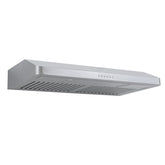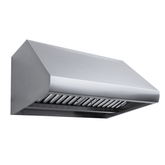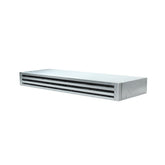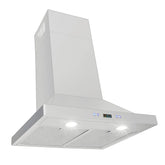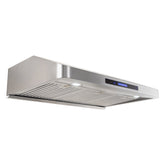Table of Contents
Is an Outdoor Ductless Hood a Good Idea?
When deciding on a range hood for your outdoor kitchen, one of the most important things to consider is ducting. You might be wondering: can I install a ductless range hood outside?
It’s not recommended to install a ductless range hood outside. A ductless hood won’t vent all the heavy smoke produced by your grill or strong cooking odors out of your cooking area. With a ductless hood outside, walls and overhangs will accumulate grease and require frequent cleaning.
Ductless hoods use charcoal filters, which capture some grease and neutralize some odors. But they are not designed to keep up with outdoor grills.
Many people think that you can invest in a ductless hood to save money and save time on installation. Although that’s true for indoor installations, you’ll end up having problems over time if you install a ductless hood outside.
We’ll go over these misconceptions and then give you some tips on how to choose the best outdoor hood for you.
Be sure to check out this blog article for additional help: Don’t Install Your Range Hood Until You Read This Ultimate Guide!
Myth: A Ductless Hood is Cost-Effective (Debunked)
You might think that a ductless hood installed outside will save you money. But in reality, you won’t get your money’s worth. A ductless hood simply won’t have enough power to keep your outdoor kitchen air clean and fresh.
After a few weeks of use, you may discover that the filters need replacement frequently. Smoke and odors may persist in your cooking space. Since your range hood isn’t doing what it’s meant to do, you’ll need to buy a new one. That’s not cost-effective! Chances are high that you’ll convert your hood to ducted or buy a ducted hood after a few weeks of using your ductless one.
Another reason people may choose a ductless hood for their outdoor kitchen is that it’s easy to install. Although it’s easy to install, the ease of installation does not outweigh the drawbacks. To effectively vent heavy smoke and grease from an outdoor grill, you need ductwork.
In some situations, ductwork can be optional. For example, if you live in an apartment where it’s not allowed. Or, if you cook sparingly indoors and just want to keep a little smoke and occasional cooking odors at bay. But, in outdoor kitchens, ductwork is not optional.
Learn more about ductless hoods in this post.
The Solution: Invest in a Ducted Outdoor Vent Hood

So, how do you avoid the hassle of maintaining a ductless hood that doesn’t vent adequately? Buy a ducted outdoor hood. At Proline, we have a wide selection of professional outdoor range hoods. They pack more than enough power to vent heavy smoke and cooking exhaust.
Take a look at four of our best outdoor range hoods at this link. If you are looking for a 60” hood, check out this post. Or if you are after the most powerful outdoor hoods, see our list of 2000 CFM outdoor hoods.
Is an outdoor ductless hood vent a good idea?
You should not install a ductless range hood outside. A ductless hood will be incapable of venting the heavy smoke and strong odors produced by your outdoor grill out of the cooking area. Without proper ducting, the walls and overhangs around your outdoor cooking area will quickly become coated in grease, requiring frequent cleaning.
While ductless hoods may seem cheaper upfront and easier to install, they simply lack the power necessary for outdoor use. You will likely end up having to replace the ductless hood with a properly ducted model after realizing it cannot handle your outdoor cooking needs.
Instead, you must invest in a ducted outdoor range hood from the start. Look for models with CFM ratings of at least 1200 CFM to ensure they can capture and expel all the smoke, grease and odors generated by your grill setup. Ducted outdoor hoods, while more expensive, are the only effective solution for an outdoor kitchen. Failure to use a ducted hood will result in inadequate venting and a mess to constantly clean up.
Outdoor Range Hood Buyer’s Guide
When looking for a quality outdoor range hood, there’s a lot to consider. Here are four of the most important factors: CFM, size, filters, and material.
CFM
You’ll want at least 1200 CFM for your outdoor range hood. 600 to 900 CFM is ideal for indoor hoods but you need more power for an outdoor vent hood. 1200 CFM will work great for most homeowners. But if you have a unique setup with two or three grills, side burners, or other extras, you might want to consider more power. If you grill every day, you also may want more than 1200 CFM.
Here’s more information on how much CFM you need for your hood.
Size
Range hood size is particularly important when choosing your outdoor hood. All you need to do is take your kitchen range or grill and add 12” to it. So if you have a 36” outdoor grill, a 48” range hood is ideal. This gives you maximum coverage and ensures all the smoke and odors is vented out of your cooking area.
The range hood should extend 6” past your grill on each side.
Want a quick and easy way to build an outdoor kitchen? Check out our Outdoor Kitchen Kits Ultimate Guide!

Filters
There are three different types of range hood filters. Baffle, mesh, and charcoal. Baffle filters are the most efficient at capturing grease, followed by mesh filters. Baffle filters are the best choice for your outdoor range hood. Ductless range hoods use replaceable charcoal filters. These filters remove some grease and odors but are not as efficient as baffles.
Material
When shopping for an outdoor range hood, look for one with outdoor-rated material. The most popular outdoor-rated material is 304 stainless steel. It is corrosion resistant and weather resistant so it can last in your outdoor space for years.
That’s it for the four most important things to consider before buying your outdoor hood.
Once you buy your outdoor range hood, make sure you mount it appropriately. Learn more here.
Hopefully we answered your question ‘can I install a ductless range hood outside?’ Focus on ducted range hoods for your outdoor kitchen to get the most out of your investment.
Conclusion
When it comes to choosing between a ducted or recirculating range hood, the decision depends on your cooking style and ventilation needs. Ducted range hoods are the ideal choice for outdoor use, as they use powerful ducted exhaust systems to expel stale and dirty air outside your outdoor kitchen area. Vented range hoods with mesh or baffle filters offer optimum performance by using much more fan power to capture grease, smoke, and odors. For indoor use or with electric stoves with lighter cooking, a high-quality recirculating range hood with an activated charcoal filter can recirculate and clean the air effectively. However, outdoor or gas stoves requiring external ventilation are better paired with a ducted system to ensure proper venting.
While ductless models or ventless hoods may seem convenient, they simply recirculate air through hood filters and charcoal filters rather than venting it outside. This can lead to lingering cooking odors and dirty air being redistributed if the filters aren't properly maintained. When selecting the right range hood, consider your cooktop type, air quality needs, and kitchen layout. Ducted hoods offer the most effective path for removing exhaust and ensuring a fresh cooking environment, but a high-quality recirculating kit can be a good ductless alternative in some cases. The ideal setup combines the correct CFM, filter types, and ducted or ductless design for your needs.
Related Articles
How to Get Your Outdoor Kitchen Ready for Summer
How to Start a Charcoal Grill (4 Effective Methods)
Can you use a cast iron skillet on the grill? (Explained)
Looking for the best outdoor range hoods? Explore our top recommendations.
View Outdoor Hoods